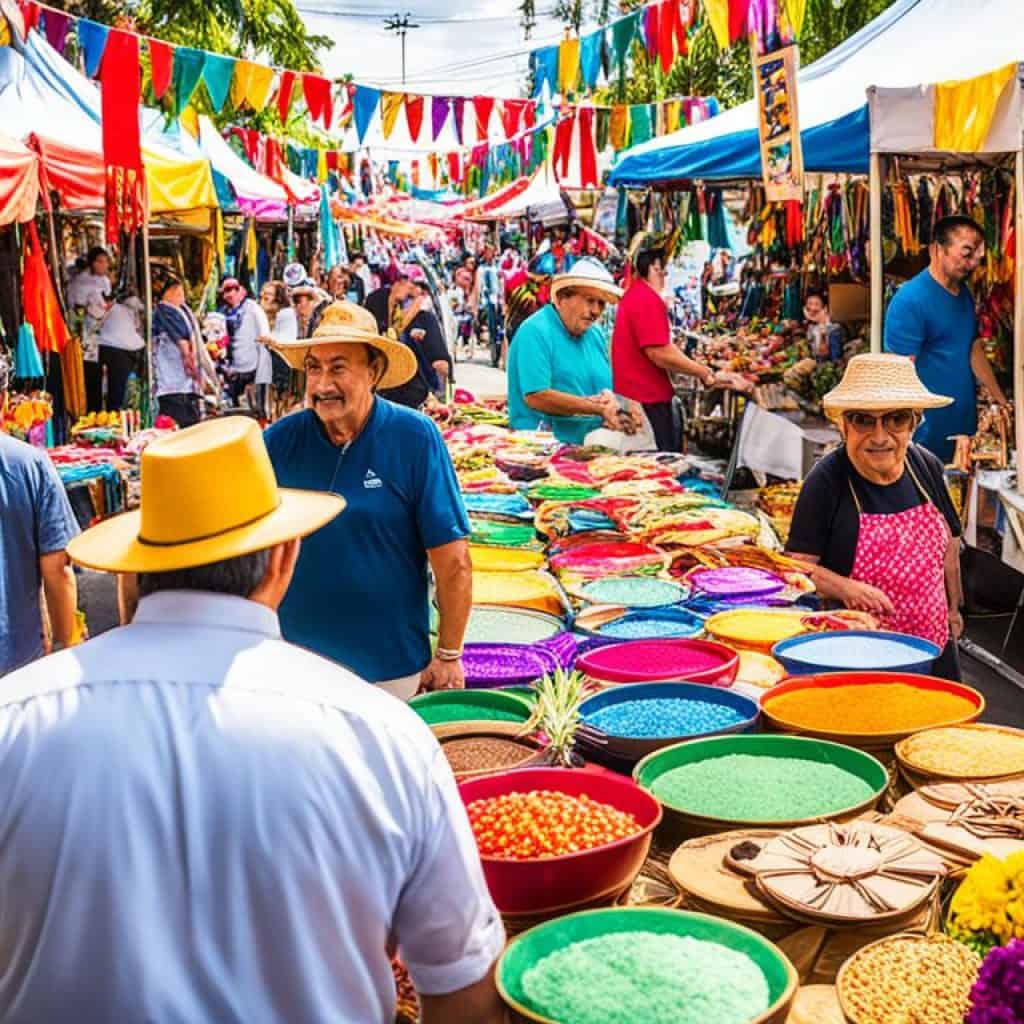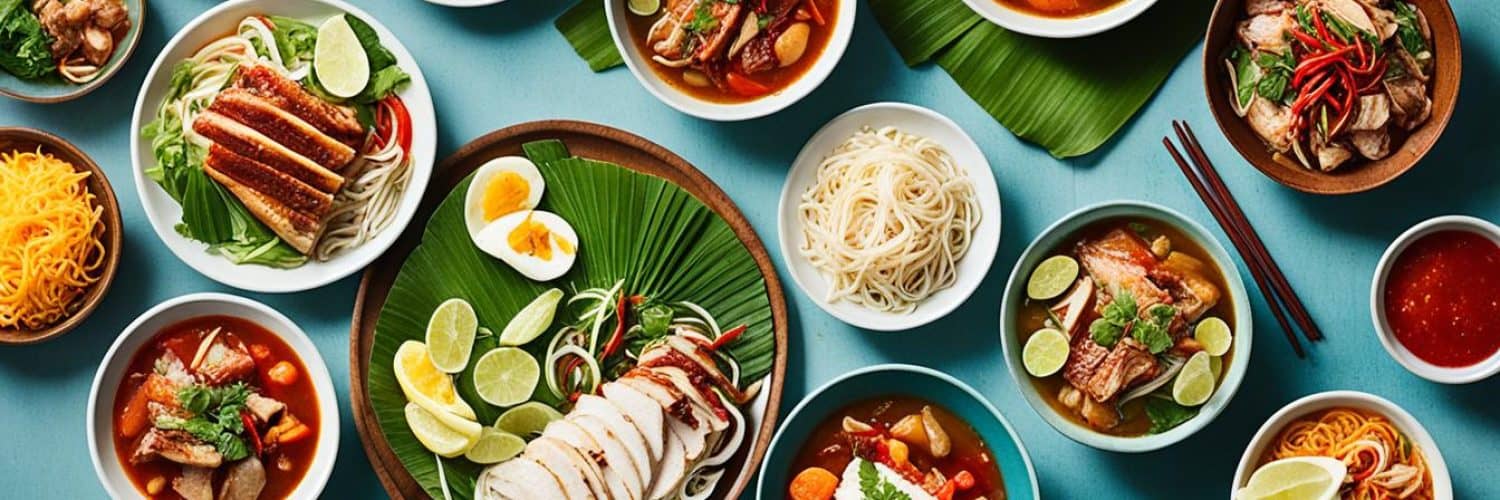Ever thought about the wonderful tastes that make up the Philippines’ diverse food scene? FilipinoCuoid introduces us to a mix of flavors from all over, offering a delicious look at Southeast Asia’s food culture. It invites you to explore the country’s rich tradition, from Manila’s famous street snacks to special dishes highlighting local ingredients and cooking methods.1
This unique fusion has caught the interest of over 5.5 million people on FilipinoCupid for dating.1 It brings together different elements to reflect the nation’s various cultural influences. For example, you can taste Manila’s popular street foods and discover dishes that represent the abundance of the Philippines. This journey through their cuisine is a journey through their history and traditions.
Key Takeaways:
- FilipinoCuoid is a fusion of flavors, drawing influences from Malay, Chinese, Spanish, and American cuisines.
- The cuisine showcases the diverse regional specialties of the Philippines, each reflecting unique cultural and environmental influences.
- Iconic Filipino street food, such as isaw and halo-halo, offer a tantalizing glimpse into the country’s vibrant culinary heritage.
- Traditional recipes have been passed down through generations, preserving the techniques and flavors that define Filipino cuisine.
- Coconut, vinegar, and fish sauce are key ingredients that lend distinctive flavors to many Filipino dishes.
What is FilipinoCuoid?
FilipinoCuoid is vibrant cuisine from the Philippines. It blends many flavors from Malay, Chinese, Spanish, and American traditions. This mix creates a delightful balance of sweet, sour, salty, and savory tastes. The country’s diverse geography also plays a big part. Each area brings its own dishes and ways of cooking.
A Fusion of Flavors
FilipinoCuoid mixes different influences into one exciting cuisine. It combines the tastes of the Malay, Chinese, Spanish, and American food cultures. This blending creates a delightful range of flavors that please the senses.
Influences from Around the World
For ages, the Philippines has soaked up various cultures. This fusion is seen clearly in its lively food scene. FilipinoCuoid shows how the Philippines welcomes food from all over. It uses techniques and ingredients from many places. This makes the food unique and full of flavor. The platform offers a chance to connect with over 5.5 million singles looking for love globally.2
Regional Specialties of the Philippines
The Philippines has many regional culinary specialties, showing unique local influences. Luzon stands out with dishes like adobo and sinigang, thanks to its plentiful seafood and produce. The Visayas are known for puto and lechon‘s tasty flavors. In Mindanao, you find a mix of Islamic and indigenous tastes with dishes such as beef rendang and tiyula itum.3
Luzon’s Culinary Delights
Luzon offers a variety of foods because it’s the biggest and most populated island. Here, you’ll enjoy dishes rich in seafood and produce. Meals like adobo and sinigang have made a name for themselves not just in the Philippines but also worldwide.4
Visayan Delicacies
The Visayas serve up sweet and sticky puto and flavorful lechon. These dishes are celebrated parts of the region’s food culture.3
Mindanao’s Distinct Flavors
Mindanao brings unique flavors by blending Islamic and indigenous influences. You can taste this mix in dishes like beef rendang and tiyula itum. These meals highlight the varied and rich Filipino cuisine.3
Exploring Filipino Street Food
The streets in the Philippines are always lively. They show off a wide variety of delicious street foods. It’s not hard to find something you like, from the grilled pork or chicken intestines called isaw to the garlic-flavored fried rice known assinangag. These foods give us a taste of the country’s food traditions.
Hal-halo is a favorite for many, a sweet and icy treat. Then there’s the empanada, a delightfully crunchy snack. Don’t forget about the juicy siopao, filled with either meat or custard.
filipinocuoid: A Journey Through Tradition
FilipinoCuoid isn’t just about tasty food. It’s a journey that honors the Philippines’ culture and history.5 Its dishes have deep roots, passed down for many generations. Families keep alive the ways and tastes that make Filipino food special.
This tradition shows the mix of many cultures and places. It brings a rich variety of flavors and cooking styles to the table.
Heirloom Recipes Passed Down
The essence of FilipinoCuoid is in its heirloom recipes. They are the heart of many Filipino families, passed through time.5 These special dishes reflect old traditions. They show how Filipino cooking has evolved, proving the country’s food culture’s strength.
From famous adobo to the soul-warming sinigang, each dish is a story. It talks about the Filipinos’ lasting love for their food and culture.
Celebrating Cultural Diversity
FilipinoCuoid shows off the colorful mix of the Philippines. It combines Malay, Chinese, Spanish, and American food influences.5 This mix creates an exciting variety of flavors. It celebrates the nation’s many ethnic backgrounds.
From Manila’s lively barbecue stands to Mindanao’s rich beef rendang, each place has its own taste. Together, they make the Philippines’ food culture vibrant and exciting.

Key Ingredients in Filipino Cuisine
At the heart of Filipino dishes are some key ingredients. Coconut is everywhere. It’s used in curries and desserts, bringing unique flavors6. The country’s warm climate and many coasts mean vinegar and fish sauce are also vital. They give Filipino food its sour and savory taste7. Along with these, various herbs and spices shape the special flavor of Filipino food.
Coconut: A Versatile Ingredient
Coconut plays a vital role in Filipino meals with its many forms. From the fresh meat to creamy milk and sweet syrup, it’s found throughout the cuisine. Dishes range from the aromatic coconut curries to coconut-based desserts. This fruit’s versatility is key in creating the unique flavors of Filipino recipes, pinoy food, and traditional Filipino dishes.
Sour and Savory: Vinegar and Fish Sauce
In Filipino cooking, vinegar and fish sauce are essential. These ingredients are loved thanks to the country’s coasts and warm weather. The many kinds of vinegar add a tangy flavor to dishes like the famous adobo and sinigang. Likewise, fish sauce adds a savory touch to philippines cuisine and filipino recipes.
Cooking Techniques and Methods
Filipino cuisine is known for its many cooking techniques. These methods have developed over hundreds of years.8 They range from grilling isaw (grilled pork or chicken intestines) on the street to making sinangag (garlic fried rice) at home. This shows how skilled Filipinos are in cooking with different styles.
Grilling and Smoking
Grilling and smoking add a smoky taste to seafood and meats in dishes like inasal and sinuglaw.8 They make dishes tastier and give them a nice, caramelized crust. This is what makes philippines cuisine, filipino recipes, and pinoy food stand out.
Stewing and Braising
Stewing and braising make dishes rich and tender. They’re used in making adobo and kare-kare, a peanut-based stew.8 These methods blend the flavors over time, creating meals that feel both warm and full of taste.
Filipino chefs and home cooks use many methods to cook. They turn their local produce and meats into something special. This unique way of cooking captures the heart of anyone who tastes it.
Flavors and Spices of the Philippines
Filipino cuisine stands out for its amazing flavors. It uses a lot of spices and herbs. Ginger and garlic are often found in many dishes, adding a special smell and taste9. The love for spicy food in the Philippines is clear, especially with the use of chili peppers like the hot siling labuyo9. These and more spices and herbs make every meal a colorful, tasty adventure. This is what makes the food unique in the Philippines.
Ginger and Garlic
Ginger and garlic are key in Filipino cooking. They make the dishes rich and full of taste. You’ll find them in stir-fries, marinades, and stews, making everything smell and taste great. Whether it’s the tangy sinigang or the classic adobo, ginger and garlic show just how special Filipino food is.
Chili Peppers and Siling Labuyo
The Philippines really loves chili peppers, especially the siling labuyo’s hot kick. These tiny peppers make Filipino food exciting with their spiciness. Dishes like sisig with its kick or sinigang’s sour heat wouldn’t be the same without siling labuyo9. They show the country’s love for bold flavors and adventure.
Dining Etiquette and Customs
Exploring Filipino cuisine goes beyond tasting the food. It includes a rich culture and manners around eating. In the Philippines, meals are often shared, bringing together loved ones around a table full of dishes.10 Respect is key, known as paggalang in Tagalog. With over 100 ethnic groups in the Philippines, each adds its own flavor to dining traditions. Using a spoon and fork and sometimes hands to eat shows the Filipino dining way.10 Moreover, the tradition of “kamayan,” eating with hands off banana leaves, honors their culinary traditions.
| Dining Etiquette in the Filipino Culture |
|---|
| 10 The Philippines boast over 170 languages and dialects. |
| 10 Most Filipinos practice the Roman Catholic faith. |
| 10 Eating Filipino cuisine is highly cherished. |
| 10 Know some local phrases like “Salamat” (Thank you) to connect better. |
| 10 Giving food or gifts like chocolates is a kind gesture. |
| 10 It’s polite to let the oldest person at the table start eating first. |
| 10 Family includes not just close relatives, but also cousins and close friends. |
| 10 Respecting local customs, especially during religious events, is important. |

Vegetarian and Vegan Filipino Dishes
While many think of Filipino food as mainly meat, the country also offers many vegetarian and vegan choices. Classic dishes include adobong sitaw (string beans in adobo sauce), pinakbet (mixed vegetable stew), and laing (spicy taro leaves and coconut milk). These meals show how rich and varied Filipino food can be without meat.
| Vegetarian/Vegan Filipino Dish | Description |
|---|---|
| Adobong Sitaw | A classic Filipino dish made with string beans cooked in a savory adobo sauce. |
| Pinakbet | A mixed vegetable stew that combines various vegetables like eggplant, okra, and bitter melon in a flavorful broth. |
| Laing | A spicy and creamy dish featuring taro leaves cooked in coconut milk and chili peppers. |
| Ginisang Ampalaya | Sautéed bitter melon with tomatoes, onions, and garlic, often seasoned with fish sauce or soy sauce. |
| Ginataang Gulay | A medley of vegetables cooked in a rich and creamy coconut milk-based sauce. |
These vegetarian and vegan meals are not just for those avoiding meat. They also celebrate the country’s vast range of delicious vegetable-centric dishes. This shows how diverse and amazing Filipino food can be, even without meat.
Pairing Filipino Dishes with Beverages
Pairing the right drink with Filipino food can make the meal even better. The country’s traditional drinks, such as sweet halo-halo, tangy calamansi juice, and mild lambanog, enhance your dining experience. They blend perfectly with the bold mix of flavors in Filipino cuisine.11
Traditional Drinks
The shaved ice dessert, halo-halo, is a Filipino favorite. It helps cool the spice in many dishes. Calamansi juice, from a small citrus fruit, adds a zesty kick to meals. Lambanog, a coconut wine, is perfect for those wanting a light alcoholic drink. It’s smooth and sweet, fitting in with Filipino culinary traditions.
Wine and Beer Pairings
Looking for a more Western twist? Try pairing Filipino recipes with wines and beers. Sauvignon Blanc and Filipino-brewed beers highlight the food’s flavors. This method ensures a full and enjoyable dining journey. Whether you go for a local or international drink, it enriches your experience of the rich Filipino food culture.
Celebrating Filipino Festivities and Holidays
Filipino cuisine is mixed with the country’s cultural events.12 The Noche Buena feast on Christmas Eve and the Media Noche on New Year’s Eve stand out. People prepare special Filipino meals for these events.12 They enjoy dishes like ham, lechon (whole roasted pig), and fruit salad.
Noche Buena and Media Noche
The Noche Buena and Media Noche are special in the Philippines. Families come together to eat traditional filipino dishes and enjoy each other’s company. These meals reflect the philippines cuisine, filipino recipes, and pinoy food.
Fiestas and Celebrations
Fiestas and festivals happen all year round in the Philippines. They highlight local foods and the joy of sharing meals. These events are a chance to explore the philippines cuisine, filipino recipes, and pinoy food. They celebrate the country’s food heritage.13
Conclusion
FilipinoCuoid is like a magic carpet for your taste buds, showing off the Philippines’ diverse and mouth-watering dishes. These meals tell a story of the country’s rich past, mixing flavors from many lands.14 From Manila’s favorite street snacks to dishes that highlight the nation’s riches, FilipinoCuoid shines a bright light on the Filipino culinary scene.15
Get ready for a flavor blast with classics like adobo, tasty calamansi, and the delightful halo-halo. After this food trip, you’ll see Filipino cuisine in a whole new light.16 Its mix of global influences, local gems, and deep culture make every bite a memorable experience.
Start your journey into FilipinoCuoid today. Dive into the flavors, smells, and customs that make it extraordinary. Let its wonders from the hectic Manila to the serene Philippine towns open a new door to exciting tastes.
FAQ
What is FilipinoCuoid?
What are the key ingredients in Filipino cuisine?
What are some of the popular regional specialties in the Philippines?
What are some of the popular Filipino street food items?
How is Filipino cuisine influenced by the country’s diverse cultural heritage?
What are some of the popular vegetarian and vegan options in Filipino cuisine?
How do Filipinos celebrate their culinary traditions during festivities and holidays?
Source Links
- https://apps.apple.com/us/app/filipinocupid-filipino-dating/id1601320796
- https://www.filipinocupid.com/
- https://www.einpresswire.com/article/56822849/cupid-media-s-filipino-dating-site-filipinocupid-com-surges-past-2-million-member-mark
- https://pinaywise.com/philippines-dating/filipino-cupid/filipino-cupid-find-love-in-the-philippines/
- https://www.prunderground.com/filipinocupid-a-new-app-that-helps-you-to-find-a-match-when-traveling-to-philippines/0097119/
- https://www.allrecipes.com/gallery/the-best-filipino-beef-recipes/
- https://www.bostonglobe.com/lifestyle/food-dining/2019/05/14/tanam-meal-tells-story-about-filipino-food/OrRr36IEwRO8s54aBret3I/story.html
- https://panlasangpinoy.com/filipino-cuban-spanish-food-chicken-empanada-picadillo-recipe/
- https://medium.com/@paredessheryl30/top-5-filipino-dishes-you-shouldnt-miss-baf196267f71
- https://pinaywise.com/philippines-dating/meeting-your-filipino-girlfriend-for-the-first-time-a-comprehensive-guide/
- https://clubtroppo.com.au/2011/01/12/why-are-there-so-few-filipino-restaurants/
- https://asianwomenlove.com/filipino-women/
- https://www.maahsareiaebrita.com.br/10-filipina-women-thatll-rock-the-coming-year/
- https://filipinocupidusa.com/
- https://medium.com/@BlogsPulse/navigating-loves-spectrum-who-is-filipino-cupid-for-0bd8e6b156a6
- https://www.keil-erdbau.at/2023/02/19/filipinocupid-review-2021/







Add comment